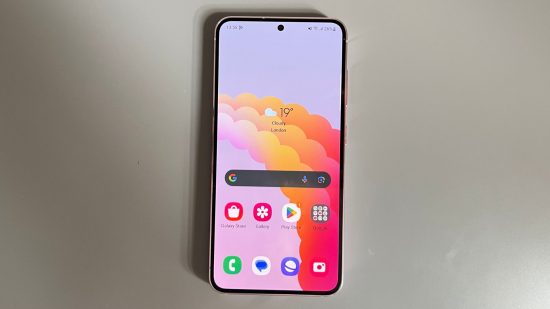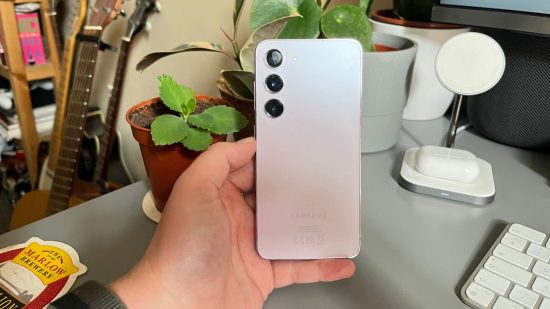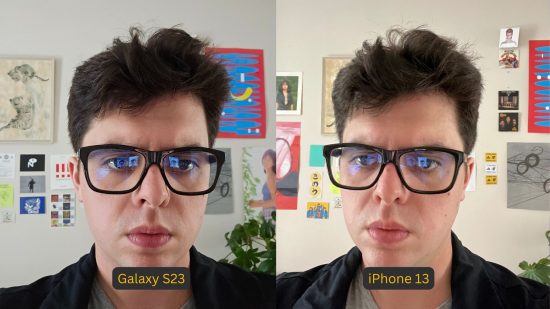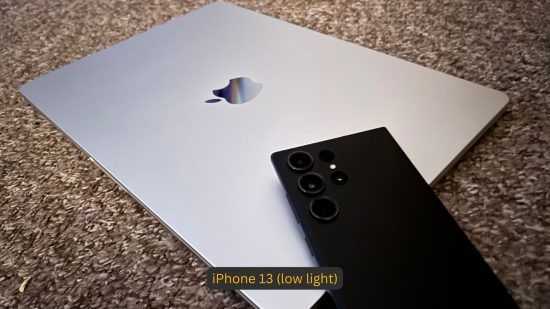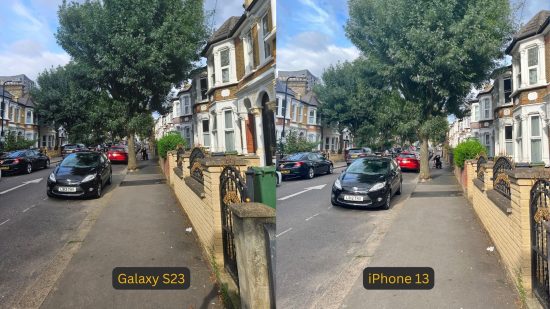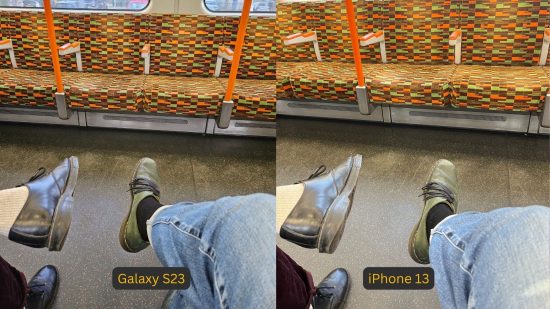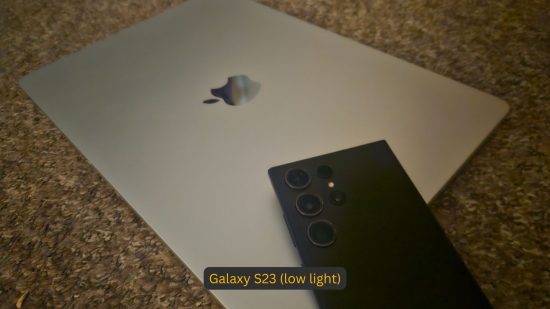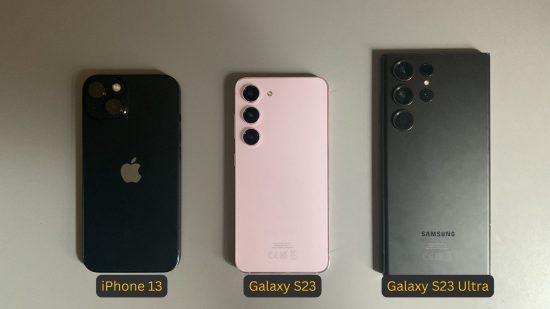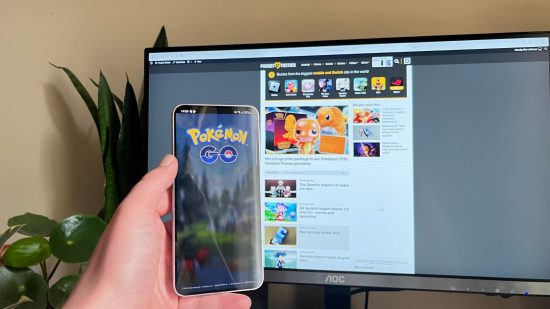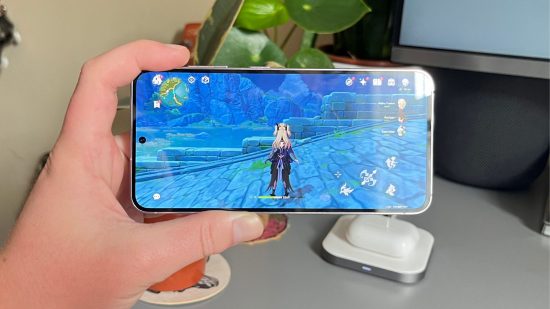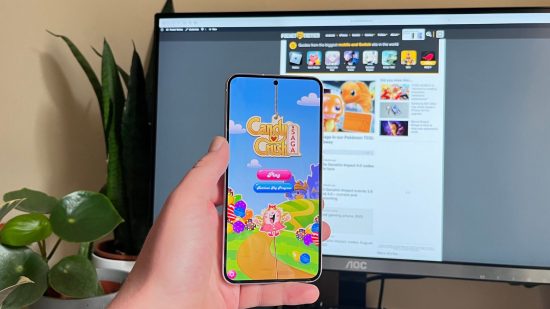Our Verdict
The Samsung S23 is a perfectly well-rounded phone with impressive cameras, excellent performance, and that long-awaited battery life improvement. It’s an absolute compact ace, doing it all with flying colors. And while that makes it a tad boring, it’s impossible not to recommend it – just don’t come looking for a personality.
The Samsung Galaxy S23 series is the easiest recommendation for anyone looking for an Android phone. Need the best of the best? The S23 Ultra is almost definitely that, for now at least. Need a budget flagship? Well, that’s the S23. And, if you need it any bigger, the S23+ is on hand to sort you out.
It’s an ace line of phones, with the overclocked Snapdragon 8 Gen 2 that’s only available in Samsung products, featuring across the whole line. It’s also in the latest Samsung phones and tablets, the two new Z series foldables, and the three sizes of the Tab S9. Samsung is wringing this chip dry, shoving it everywhere it can. And there’s good reason for that – it’s mighty powerful.
Still, power isn’t all a phone needs, and the S23 knows it. There’s a great three-camera setup, a pretty 120Hz OLED display, a neat and pleasant aesthetic, fast-enough charging, clean selfies, and a bunch of other things that make it sound like it’s the perfect phone for most people, at least on paper. And while this might be true, with all these bases covered so cleanly, it feels a tad sterile. In fact, I think the S23 is a little boring – even the vibrant Lavender I’m reviewing, yes.
But before we get to that, let’s start at the start:
Pros:
- Perfectly well-rounded
- Powerful chip for the price
- Excellent display
Cons:
Price and availability:
The Samsung Galaxy S23 is available across numerous retailers and network providers, while if you buy it directly from Samsung there are some exclusive colors. The S23 comes in Phantom Black, Cream, Green, and Lavender, while Graphite and Lime colors are exclusive to the Samsung website.
Samsung Galaxy S23 specs:
Features
The Samsung Galaxy S23 comes packed with exactly what you’d expect. There’s a fingerprint sensor, Samsung Pay, the ropey voice assistant Bixby (don’t worry, you can just use “Hey Google” instead), and the exciting but underutilized DeX that turns your phone into a desktop. It’s a Samsung phone, and it does Samsung things. Nice, but none of these are really big selling points – they’re just gubbins.
But, even without the obvious selling points, gubbins is welcome – this phone just kinda has everything you could need, and that’s before we get into the cameras, display, and performance. We’re talking image clipping, call screening, night photography, timelapses, and even more. We’ll get into the details down below, but it’s swinging for the fences with all the stuff it can do. Oh, and there’s Wi-Fi 6e and Bluetooth 5.3, so you know you’re as up-to-date as can be, too.
Camera
Let’s start with one of the Samsung Galaxy S23’s biggest selling points, then: its cameras. On the rear of the handset are three lenses; a 50MP wide camera, 10MP telephoto, and 12MP ultrawide. While these numbers don’t really mean all that much, the quality the things can produce is very lovely indeed.
The wide lens, with its f/1.8 aperture, is doing the heavy lifting here. It lets in more than enough light for nighttime shots to work like a dream, as Samsung’s new nightography processing creates really vibrant low-light shots. Nighttime shots don’t look as nice with the other two lenses, so zooming in on subjects in low light isn’t ideal.
In brighter scenes, the processing can’t seem to make up its mind: it’s either slightly washed out like a delicate old film camera without the grain, or it’s hyper-contrasty like when I used to edit photos for my Facebook profile. My guess is that this has something to do with people – if the image processing notices a subject, it seems to chill out on the deep contrast, but if not, we’re getting deeper darks and vibrant colors.
This is by no means a bad thing, but it’s definitely noticeable. If you like Samsung’s cameras then you’re going to find more of the same here, but switching from an iPhone might be more of a shock. You can take a look at a comparison between the two below if you fancy.
Meanwhile, there’s no dedicated macro camera mode, so taking close-up shots isn’t perfect. The telephoto sort of manages it, but it’s not ideal. Still, the wide camera does pull its weight, meaning non-zoomed, well-lit shots shine the best, as is the case with most phone cameras. It’s the same story with the autofocus, too – the wide lens is speedy to focus on a subject, while the telephoto and the ultrawide get a bit confused sometimes.
All this is assisted by Samsung’s ever excellent camera app, with the standard settings like night and portrait modes backed up by a plethora of other options. You can go for pro modes to get more editing freedom, panoramas, slow-mo, portrait video, and even a specific mode for taking photos of food. Yum.
There’s also the Hyperlapse option, which lets you create a high-speed timelapse. It’s not really useful except for specific use cases, but some of the examples out there of astrophotography are mightily impressive. We couldn’t try it out for lack of a tripod, but if you’re looking for that sort of gimmick, it’s here.
Basic videos look solid enough, with 4K video at 30 or 60fps and 8K video at 24 or 30fps available. Stabilization is decent enough, but having seen its big brother, the S23 Ultra, pull off some incredible footage at pace, it does leave a little to be desired – even though that’s a very unfair comparison.
Design
Maybe a fairer thing to compare the S23 to is the iPhone 14, the smartphone it’s clearly trying to compete against. And I think, for all the internal gubbins, one of the main battles Samsung needs to win is based around aesthetics, build quality, and overall design philosophy. Of course, it’s all quite subjective, but the S23 is the clear loser in my mind.
The S23 has aluminum rails around the side, fixing the Gorilla Glass Victus 2 front and back together. It’s very neat and often quite pretty, especially in the lavender color that I’m reviewing. But it’s also maybe a little too neat and fixed together, feeling a tad less luxurious than its main competitor.
While the folks at Google design Pixel phones that are definitely divisive – and really not to my liking – Samsung is keeping things simple. With no curved edges on the screen, only slightly bowed aluminum rails, and no accents beyond the very-iPhone-esque strips on said rails, it feels more iPhone than ever. It’s better when Samsung feels different to my mind – like with the S23 Ultra, a big slab of perfectly cut geometry, rather than this somewhat run-of-the-mill offering.
That being said, Samsung’s design philosophy across all its lines has come on leaps and bounds over the years, and it’s really nice how everything from the A54 all the way to the S23 Ultra look like part of the same family. The three-camera setup on the back of the S23 is likely the prettiest arrangement at the moment, with the iPhone’s square bumps and the rest of the competition feeling a little clunkier.
In terms of durability, the Samsung Galaxy S23 has all the promises you need. Its IP68 rating means it’s happy to go underwater for a little bit (30 minutes up to 1.5 metres, to be exact) and can withstand dust too. Meanwhile, Gorilla Glass Victus 2 on the front and back is as good as it gets at the time of writing. As I’ve said, the S23 is neat – it has everything you need.
Display
When it comes to the display, however, neat might not be the right adjective. With a 120Hz refresh rate, 1750 nits peak brightness, and a general richness to the colors throughout, it’s just a bit bonkers – an excellent display that handily beats many competitors at this price.
That high refresh rate isn’t just a fun number that your phone is never going to hit – it makes gliding through menus and app screens so silky smooth that it’s impossible to go back to 60Hz without feeling that something is missing. If you’re still on a 60Hz display, the jump up may not feel that noticeable, but going back down is always a bummer.
While the display is more than good enough for anyone, offering everything the S23 Ultra does at just a minutely lower pixel density, it does make everything a little more vibrant than you may be used to. This is because the phone automatically opts for vivid mode when you set it up, reducing color accuracy but making everything pop a bit more. The Nintendo Switch does the same thing, and it kinda works there, but on a day-to-day phone, I’d recommend switching the display setting from vivid to natural.
All that being said, however, this AMOLED screen is just unbeatable. It’s excellent for watching stuff or playing games – though of course it’s compromised a tad by the S23’s more compact size. If you often find yourself watching videos on your phone, this is an excellent way to do it (though you may want to opt for the bigger screen of the S23+ to make sure you’re not too cramped).
Battery
With a 3900mAh battery, the S23 is on the lower end of the spectrum for Android phones. Sure, it has a smaller screen, so it just uses less battery in general, but it’s still not a reassuring thing to see on a spec sheet. Well, any worries are completely unfounded, as in spite of its smaller size, the Galaxy S23 has more than enough juice to get through a full day of consistent use.
Heading to bed after being outside all day – using the phone for messages, social media, YouTube, and a few casual videogames while on the train – rarely brought any battery concerns. I’d happily let it lie on my nightstand and charge it in the morning. And this was all when I was really testing the phone out quite a lot. A standard day of use for most people differs, sure, but I suspect usual day-to-day users are going to have no battery troubles. Oh, and if you’re coming from an S22, you’re going to see a huge leap forward.
Plus, once you do manage to fully drain the battery, 25W wireless charging is here to get you back up and running. It’s advertised as offering 50% charge in 30 minutes, but, because the whole S line of phones do not come with a charging plug, I could only test with a 20W wall plug. I got 50% in 40 minutes, so I was exactly suffering – but if you don’t have a high-wattage plug, you’re not getting one in the box, so be prepared.
Performance
All that wonderful battery news is likely down to the new chip, though it offers far more than just that. We even had a chance to ask in Samsung’s Won-joon Choi interview all about the chip’s new capabilities, like ray-tracing. And while we don’t think these big claims really make any real-world difference, the sheer performance of the thing is more than enough for whatever you throw at it.
PUBG Mobile, on fully maxed out settings, runs at a completely stable 40fps, which is decent – though the cluttered HUD does make it an unideal experience given the smaller screen size of the S23. It works, but messy games might not be the best fit.
The same applies to CoD Mobile – it’s the sort of game where a bigger screen would be preferable, though it does run excellently here. The game runs maxed out at 60fps straight from first launch, and the whole experience is nice and smooth.
Genshin Impact, meanwhile, runs just as you’d expect, maintaining a reasonable 30fps on maximum graphical settings. There are some small drops and noticeable stutter when things get a bit busy, but that’s usually the way with Genshin. It still looks pretty darn pretty on the S23.
Of course, throwing anything more casual at the S23 is a bit of a waste of time. Obviously Candy Crush runs without a hitch, while Clash of Clans is similarly smooth. This should come as no surprise, of course, but it’s good to know. The main issue is always going to be screen size, but that’s a sacrifice you make for this phone’s pocketability – a very worthwhile tradeoff if you’re not a mobile-game obsessive.
Throughout all my testing, the phone only got reasonably toasty during the Genshin asset download. Even a reasonably extended session of Honkai didn’t make the phone much more than warm. This is impressive, given its small size and lack of the S23 Ultra’s vapor chamber. Over about two hours of intermittent game testing and asset downloads, I only lost 22% battery, too, which isn’t much at all.
Of course, this power isn’t just here to help you spend some time in Teyvat. It also means that everything works smoothly day to day. This is definitely the case, with fast menus and clean animations, plus most apps opening quickly and without a hitch. OneUI is a clean Android experience that I think anyone can get to grips with, especially with this sort of power behind it.

Verdict
The Samsung S23 is an unmitigated success – there isn’t really anything wrong with it (unless you’re used to superfast charging speeds). From an excellent camera setup to one of the best screens in this price range, it’s a well-rounded, balanced, and impeccable bit of kit. If you want a powerful Android phone in a small form factor, this only really has one proper competitor, as you can learn about in our Asus Zenfone 10 review. And even then, the S23 has a better camera, so it’s probably your best bet.
But, if it were my money, I’d probably buy the Zenfone. Because the S23 seems to lack a charm in any of its perfection. There’s just a general safety to it all – packing the phone with the best tech and then saying, ‘here ya go’ – that I find quite dull. And that’s such a nebulous issue that it would never change my recommendation. You should buy this phone. There’s a lack of personality that most folks are unlikely to take issue with. But it’s an issue for me.
Alternatives
Asus Zenfone 10
As we mentioned earlier, the Asus Zenfone 10 is the new king of the compact phone, with a slightly smaller screen and form factor than the S23 (only a handful of millimeters smaller, mind you). They’re pretty closely matched, and while the S23 has better cameras, the Zenfone has a headphone jack, a clever new touch-interactive button for navigation, and a bucket-load more charm to boot. You can learn more in our Asus Zenfone 10 review.
iPhone 14
If the S23 isn’t boring enough for you, you could get an iPhone 14. Of course, I’m joking – I’m an iPhone user – but the debate over iPhone vs. Android has definitely concluded that Apple is the simple side. Come over if you want an incredibly similar phone in terms of performance, camera, and battery life, but one that’s running iOS. This is your best bet if you want an Apple Watch, Mac, AirPods, or HomePod, of course. But once you’re in, you might not be able to leave…
